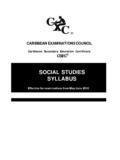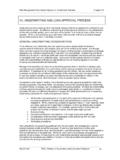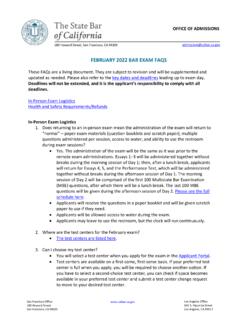Transcription of Types of Language Tests - univ-tlemcen.dz
1 1 University of Tlemcen Department of English Master 1: DAELE Dr. N. BENMOSTEFA Types of Language Tests The needs of assessing the outcome of learning have led to the development and elaboration of different test formats. Testing Language has traditionally taken the form of testing knowledge about Language , usually the testing of knowledge of vocabulary and grammar. Stern (1983, p. 340) notes that if the ultimate objective of Language teaching is effective Language learning, then our main concern must be the learning outcome . In the same line of thought, Wigglesworth (2008, p. 111) further adds that In the assessment of languages, tasks are designed to measure learners productive Language skills through performances which allow candidates to demonstrate the kinds of Language skills that may be required in a real world context.
2 This is because a specific purpose Language test is one in which test content and methods are derived from an analysis of a specific purposes target Language use situation, so that test tasks and content are authentically representative of tasks in the target situation (Douglas, 2000, p. 19). Thus, the issue of authenticity is central to the assessment of Language for specific functions. This is another way of saying that testing is a socially situated activity although the social aspects have been relatively under-explored (Wigglesworth, 2008). Yet, Language Tests differ with respect to how they are designed, and what they are for, in other words, in respect to test method and test purpose. In terms of method, we can broadly distinguish traditional paper-and-pencil Language Tests from performance Tests .
3 Paper-and-pencil Language Tests are typically used for the assessment either of separate components of Language knowledge (grammar, vocabulary etc.), or of a receptive understanding (listening and reading comprehension). In performance-based Tests , the Language skills are assessed in an act of communication. Performance tests1 are most commonly Tests of speaking and writing, for instance, to ask a Language learner to introduce himself or herself formally or informally and to write a composition, a paragraph or an essay, 1 A performance test is a test in which the ability of candidates to perform particular tasks, usually associated with job or study requirements, is assessed (Davies et al., 1999, p. 144). 2 on the way he or she spent her summer holidays.
4 These examples are elicited in the context of simulations of real-world tasks in realistic contexts. In terms of purpose, several Types of Language Tests have devised to measure the learning outcomes accordingly. However, each test has its specific purpose, properties and criterion to be measured2. The test Types that will be dealt with in this part have been laid-out not in terms of importance, they are all of equal importance, but on the basis of alphabetical order. Yet, dictation, the traditional testing device which focuses much more on discrete Language items, will have its fair of attention in terms of its pro s and con s. 1. Achievement Test An achievement test, also referred to as attainment or summative test, are devised to measure how much of a Language someone has learned with reference to a particular course of study or programme of instruction, end-of-year Tests designed to show mastery of a Language .
5 An achievement test might be a listening comprehension test based on a particular set of situational dialogues in a textbook. The test has a two-fold objective: 1) To help the teachers judge the success of their teaching. 2) To identify the weaknesses of their learners. In more practical and pedagogical terms, Brown (1994, p. 259) defines an achievement test as Tests that are limited to particular material covered in a curriculum within a particular time frame . In other words, they are designed primarily to measure individual progress rather than as a means of motivating or reinforcing Language . Ideally, achievement Tests are rarely constructed by classroom teacher for a particular class. 2 Richards et al. (1985) define a criterion-referenced test (CRT) as: a test which measures a student s performance according to a particular standard or criterion which has been agreed upon.
6 The student must reach this level of performance to pass the test, and a student s score is therefore interpreted with reference to the criterion score, rather to the scores of the students. That definition is very different from their definition for a norm-referenced test (NRT) which they say is: a test which is designed to measure how the performance of a particular student or group of students compares with the performance of another student or group of students whose scores are given as the norm. a student s score is therefore interpreted with reference to the scores of other students or group of students, rather than to an agreed criterion score. 3 2. Cloze Test A cloze test, also alternately referred to as cloze procedure, consists of a set of techniques for measuring, for example, reading comprehension.
7 In a cloze test words are removed from a reading passage at regular intervals, leaving blanks. For example every fifth word may be removed. The reader must then read the passage and try to guess the missing words. For example, a cloze passage looks like this: A passage used in .. cloze test is a .. of written material in .. words have been . The learners must then .. to reconstruct the passage .. filling the missing .. (Adapted from Richards et al., 1989, p. 41) Here, the test-taker or the reader has to guess the following missing words: a, passage, which, removed, try, by and words. The cloze test can also be used to judge the difficulty of reading materials. If the cloze procedure is being used for Language testing, the test-taker is given a score according to how well the words guessed match the original words, or whether or not they make sense.
8 Two Types of scoring procedure are used: 1) The reader must guess the exact word which was used in the original (as in the example) above. This is called exact word method. 2) The reader can guess any word that is appropriate or acceptable in the context. This is called the acceptable word method. Another illustrative example of close test looks something like the following: A week has seven .. The only word which will fit in this blank is days . But sometimes one can choose between two or more words, as in: We write with . In this blank one can write pen or pencil or even chalk , computer or typewriter . However, two substantial criticisms have been made to the cloze-test Types (Broughton et al., 1980). The first of these criticisms is that such Tests rarely afford the person being tested any opportunity to produce Language spontaneously.
9 The second is that they are fundamentally trying to test that knowledge of the Language system that underlies any actual instance of its use linguistic competence in the Chomskyan sense- they are not concerned with the ability to 4 master the Language system for particular purposes with particular people in particular situations. 3. Diagnostic Test As its name denotes, a diagnostic test is primarily designed to diagnose some particular linguistic aspects. Diagnostic Tests in pronunciation, for example, might have the purpose of determining which particular phonological features of the English Language are more likely to pose problems and difficulties for a group of learners. One of the well-known diagnostic Tests in English is Prator s (1972) Diagnostic Passage. It consists of a short written passage that the learner reads orally; the teacher then examines a tape recording of that reading against a very detailed checklist of pronunciation errors.
10 Basically, diagnostic Language Tests have a three- fold objective: 1. To provide learners with a way to start learning with their own personal learning programme or what would be called in the literature of testing learning paths. 2. To provide learners with a way to test their knowledge of a Language . 3. To provide learners with better information about their strengths and weaknesses. Ideally, diagnostic Tests are designed to assess students linguistic knowledge (knowledge of and about the Language ) and Language skills (listening, speaking, reading and writing) before a course is begun. However, the term formative is sometimes used to designate a diagnostic test. One of the main advantages of a diagnostic test is that it offers useful pedagogical solutions for mixed-ability classes. In this very specific context, Broughton et al.




